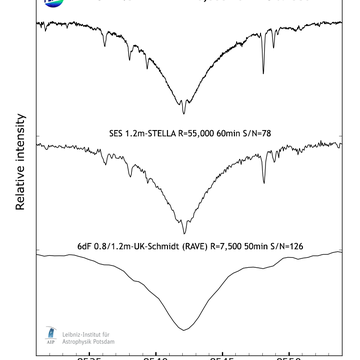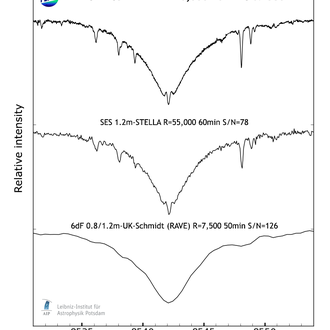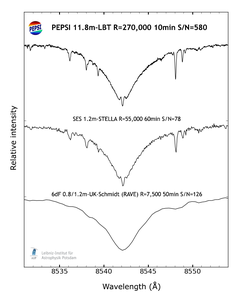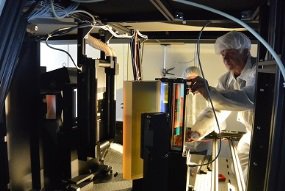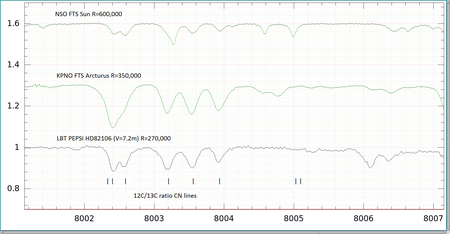First Light for PEPSI
The Potsdam Echelle Polarimetric and Spectroscopic Instrument (PEPSI) has received its first celestial light through the Large Binocular Telescope (LBT). Astronomers from the Leibniz Institute for Astrophysics Potsdam showed the instruments incredible capabilities at different wavelengths and resolving powers. Among the first targets were several of the bright Gaia-ESO benchmark stars, magnetically active stars, solar-like stars with planets, a solar twin in M67, Jupiter’s four Galilean moons, and the bright Nova Sgr 2015b.
On April 1st, the 2 x 8.4m mirrors of LBT, effectively an 11.8m telescope, were turned to the K3 dwarf star HD 82106, and PEPSI received its first celestial photons through the world’s largest telescope. The instrument splits the stellar light into a spectrum with a wavelength resolution otherwise only obtainable in solar physics. The commissioning team of four AIP astronomers on the 3200m Mt. Graham in Arizona was preceded by a team of five who prepared the instrument for this event.
The star was only the first in a series of commissioning targets that test the instrument’s resolving powers at different wavelengths. Switching between resolution modes or between wavelength settings takes less than a minute and can be done any time. PEPSI is the only instrument that enables astronomers to point to bright stars as well as to faint quasars during the same night.
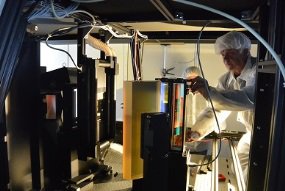
PEPSI at LBT
Technical key facts
Three spectral resolutions of λ/Δλ=43,000, 120,000 or 270,000 are provided and cover the entire optical/red wavelength range from 383 to 907 nm in three exposures. One resolution element of the 270,000-mode is sampled by two pixels on the CCD detector and amounts to 24 mÅ or an equivalent velocity of 1.2 km/s. The 43,000 and the 120,000-mode sample their resolution element with 12 and 4 pixels, respectively, which amounts to an effective wavelength resolution of 145 mÅ and 50 mÅ, or 7.2 and 2.5 km/s, respectively. Two 10.3k x 10.3k CCDs with 9μm pixels and peak quantum efficiencies of 94-96% record a total of 92 echelle orders.
Switching between resolution modes or between wavelength settings takes less than a minute and can be done any time which enables PEPSI to point to bright stars as well as to faint quasars during the same night. To compensate instrumental drifts PEPSI incorporates the simultaneous reference technique where the spectrum of a stabilized Fabry-Perot fringe pattern is recorded simultaneously with the target star on the detector.
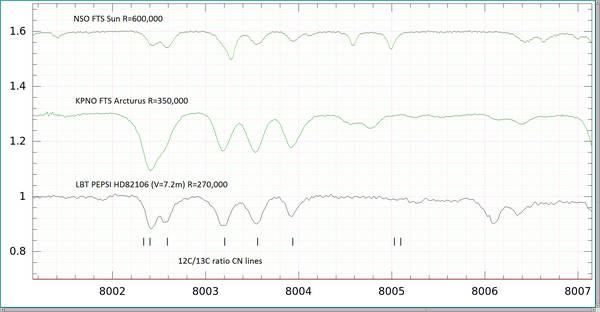
Star spectrum of HD 82106 compared to the Sun and Arcturus (detail).
Science Contact and Principal Investigator: Prof. Dr. Klaus G. Strassmeier
Project scientists: Dr. Ilya Ilyin and Dr. Michael Weber
Media contact: Dr. Janine Fohlmeister, +49 331 7499 383
The Potsdam Echelle Polarimetric and Spectroscopic Instrument (PEPSI) has received its first celestial light through the Large Binocular Telescope (LBT). Astronomers from the Leibniz Institute for Astrophysics Potsdam showed the instruments incredible capabilities at different wavelengths and resolving powers. Among the first targets were several of the bright Gaia-ESO benchmark stars, magnetically active stars, solar-like stars with planets, a solar twin in M67, Jupiter’s four Galilean moons, and the bright Nova Sgr 2015b.
On April 1st, the 2 x 8.4m mirrors of LBT, effectively an 11.8m telescope, were turned to the K3 dwarf star HD 82106, and PEPSI received its first celestial photons through the world’s largest telescope. The instrument splits the stellar light into a spectrum with a wavelength resolution otherwise only obtainable in solar physics. The commissioning team of four AIP astronomers on the 3200m Mt. Graham in Arizona was preceded by a team of five who prepared the instrument for this event.
The star was only the first in a series of commissioning targets that test the instrument’s resolving powers at different wavelengths. Switching between resolution modes or between wavelength settings takes less than a minute and can be done any time. PEPSI is the only instrument that enables astronomers to point to bright stars as well as to faint quasars during the same night.

PEPSI at LBT
Technical key facts
Three spectral resolutions of λ/Δλ=43,000, 120,000 or 270,000 are provided and cover the entire optical/red wavelength range from 383 to 907 nm in three exposures. One resolution element of the 270,000-mode is sampled by two pixels on the CCD detector and amounts to 24 mÅ or an equivalent velocity of 1.2 km/s. The 43,000 and the 120,000-mode sample their resolution element with 12 and 4 pixels, respectively, which amounts to an effective wavelength resolution of 145 mÅ and 50 mÅ, or 7.2 and 2.5 km/s, respectively. Two 10.3k x 10.3k CCDs with 9μm pixels and peak quantum efficiencies of 94-96% record a total of 92 echelle orders.
Switching between resolution modes or between wavelength settings takes less than a minute and can be done any time which enables PEPSI to point to bright stars as well as to faint quasars during the same night. To compensate instrumental drifts PEPSI incorporates the simultaneous reference technique where the spectrum of a stabilized Fabry-Perot fringe pattern is recorded simultaneously with the target star on the detector.

Star spectrum of HD 82106 compared to the Sun and Arcturus (detail).
Science Contact and Principal Investigator: Prof. Dr. Klaus G. Strassmeier
Project scientists: Dr. Ilya Ilyin and Dr. Michael Weber
Media contact: Dr. Janine Fohlmeister, +49 331 7499 383
Images
Spectrum of HD 82106 in comparison to other AIP observatories.
PEPSI at LBT
Star spectrum of HD 82106 compared to the Sun and Arcturus (detail).
Big screen size [1000 x 521, 130 KB]
Original size [1895 x 988, 60 KB]
